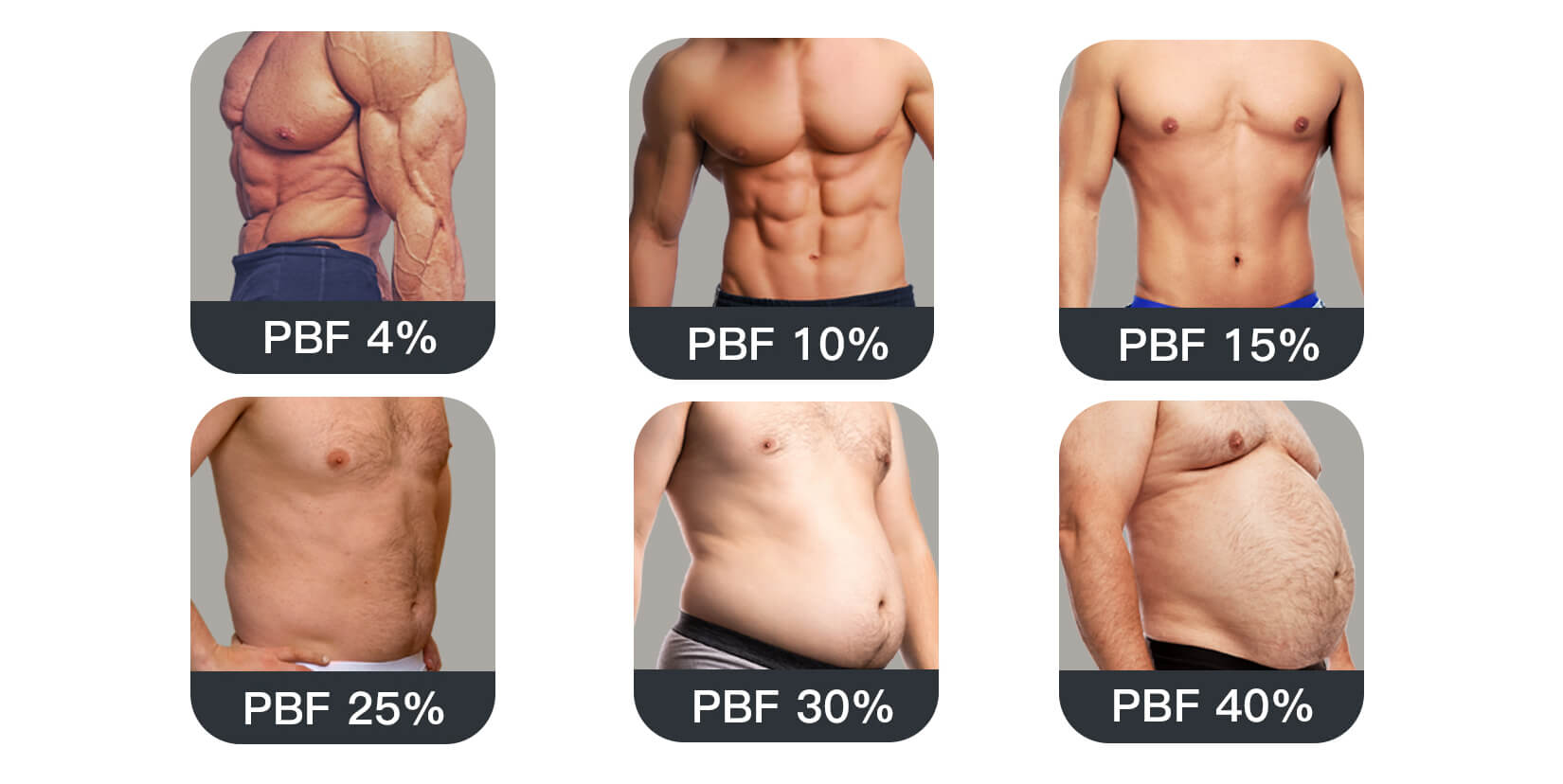-
Figure out Your Baseline
Understand what you need to lose, gain, or maintain to achieve your ideal body composition.
-
Focus on Fat Loss
Assess your body fat percentage to prioritize fat loss instead of just weight loss.
-
Tailor Your Workouts
Pair text with an image to focus on your chosen product, collection, or blog post. Add details on availability, style, or even provide a review.
-
Personalize Your Nutrition
Calculate your caloric needs and develop a customized nutrition plan.
-
Set Realistic Goals
Accurately monitor your progress and stay motivated by setting achievable targets.
-
Make Informed Decisions
Use detailed insights to improve your body composition and overall health.
Body fat mass and percentage
Body fat mass refers to the total amount of fat tissue in the body, measured in kilograms or pounds. Body fat percentage, on the other hand, is the proportion of total body weight that is made up of fat tissue, expressed as a percentage. It represents the ratio of fat mass to total body mass and is often used as a more accurate indicator of body composition and health compared to body weight alone. A lower body fat percentage is generally associated with better health and fitness.
Segmental body fat percentage
Segmental body fat percentage refers to the distribution of body fat across different segments or regions of the body. This type of analysis provides insight into how fat is distributed in various areas such as the arms, legs, trunk, and abdomen. By assessing segmental body fat percentage, individuals and health professionals can gain a more detailed understanding of their body composition and identify areas that may require specific attention in terms of diet, exercise, or health management.
Visceral fat
Visceral fat, also known as intra-abdominal fat, is the fat that surrounds internal organs in the abdominal cavity. Unlike subcutaneous fat, which is located just beneath the skin, visceral fat is deeper and can pose greater health risks. Excess visceral fat has been linked to various health problems, including insulin resistance, type 2 diabetes, heart disease, and metabolic syndrome. Therefore, reducing visceral fat through lifestyle changes such as diet and exercise is important for maintaining overall health and reducing the risk of associated health complications.
Fatty liver
Fatty liver, also known as hepatic steatosis, is a common condition marked by the accumulation of fat in liver cells. It can be categorized as non-alcoholic fatty liver disease (NAFLD) or alcoholic fatty liver disease (AFLD). NAFLD is prevalent in individuals with obesity, diabetes, and high cholesterol, while AFLD results from excessive alcohol consumption. Left untreated, it can progress to serious liver conditions. Managing fatty liver involves lifestyle changes like diet and exercise. Regular monitoring by healthcare professionals is crucial for prevention and treatment. Learn more about the causes, symptoms, and management of fatty liver.
Muscle mass
Muscle mass refers to the amount of muscle tissue in the body, typically measured in kilograms or pounds. It is a critical component of overall body composition and plays a vital role in various bodily functions, including movement, posture, metabolism, and strength. Maintaining adequate muscle mass is essential for overall health and functionality, as it helps support physical performance, bone health, and metabolic rate. Regular strength training exercises and proper nutrition are key factors in building and preserving muscle mass, particularly as individuals age and may experience muscle loss due to factors such as inactivity or illness.
Skeletal muscle mass
Skeletal muscle mass, a vital component of body composition, refers to the total amount of skeletal muscle tissue in the body. It is the type of muscle responsible for voluntary movements, such as walking, lifting, and running. Skeletal muscle mass plays a crucial role in physical performance, metabolism, and overall health. Whether you're an athlete aiming to enhance strength and endurance or someone looking to improve functional capacity and quality of life, maintaining optimal skeletal muscle mass is essential.
Segmental muscle mass
Segmental muscle mass refers to the measurement of muscle mass in specific segments or regions of the body, typically analyzed through advanced body composition assessment methods. This approach provides insights into the distribution of muscle mass throughout various body parts, such as the arms, legs, trunk, and abdomen. Understanding segmental muscle mass can help individuals and fitness professionals identify potential muscle imbalances, asymmetries, or areas requiring targeted strength training. By focusing on segmental muscle mass, individuals can develop a more balanced and functional physique, enhancing overall physical performance and reducing the risk of injury.
Total body water
Total body water (TBW) refers to the overall amount of water present in the body, encompassing both intracellular fluid (fluid within cells) and extracellular fluid (fluid outside cells). It is a critical component of body composition and plays a vital role in various physiological processes, including hydration, temperature regulation, nutrient transportation, and waste removal. Understanding TBW is essential for assessing hydration status and overall health. By monitoring TBW levels, individuals and healthcare professionals can gauge hydration levels and make informed decisions regarding fluid intake to maintain optimal health and well-being.
Bone mass
Bone mass, a critical component of body composition, refers to the total amount of bone tissue in the body. It is a key determinant of bone strength, density, and overall skeletal health. Maintaining healthy bone mass is essential for preventing osteoporosis and reducing the risk of fractures and other bone-related conditions. Factors such as genetics, diet, physical activity, and hormonal balance influence bone mass throughout life. Regular weight-bearing exercise, adequate calcium and vitamin D intake, and other lifestyle habits play crucial roles in optimizing bone mass and minimizing the risk of bone loss over time.
Basal Metabolic Rate (BMR)
Basal Metabolic Rate (BMR) refers to the minimum amount of energy or calories that your body requires to maintain basic physiological functions while at rest. These functions include breathing, circulating blood, regulating body temperature, and supporting organ function. BMR accounts for the largest portion of your daily energy expenditure, typically representing around 60-75% of total calories burned each day, depending on factors such as age, gender, body composition, and activity level. Understanding your BMR is crucial for establishing personalized nutrition and weight management plans, as it serves as a baseline for determining daily caloric needs and achieving health and fitness goals.
Body Mass Index (BMI)
Body Mass Index (BMI) is a numerical value calculated based on an individual's weight and height. It is used as a screening tool to assess whether a person has a healthy body weight for their height. The formula for BMI is weight in kilograms divided by the square of height in meters (BMI = weight(kg) / height(m)^2).
BMI is often categorized into the following ranges:
- Underweight: BMI less than 18.5
- Normal weight: BMI between 18.5 and 24.9
- Overweight: BMI between 25 and 29.9
- Obesity: BMI of 30 or higher
While BMI provides a quick and easy way to assess body weight status, it does not directly measure body fat and may not accurately reflect individual differences in body composition, such as muscle mass. Therefore, it is best used as a general guideline and should be interpreted alongside other factors such as waist circumference, body fat percentage, and overall health status.
Waist-Hip Ratio (WHR)
The Waist-Hip Ratio (WHR) is a measurement that compares the circumference of the waist to that of the hips. It is calculated by dividing the waist circumference by the hip circumference.
WHR is used as an indicator of body fat distribution and overall health risk. Research has shown that individuals with higher WHR (indicating more weight around the waist) may have an increased risk of certain health conditions such as heart disease, type 2 diabetes, and stroke, compared to those with lower WHR.
A healthy WHR varies depending on gender, but generally, a WHR of 0.85 or lower for women and 0.90 or lower for men is considered favorable. However, it's important to note that WHR should be interpreted alongside other health indicators and risk factors, and individual variations should be taken into account.
Protein
Protein is a crucial macronutrient that plays a variety of essential roles in the body. It is made up of amino acids, which are the building blocks of tissues, muscles, organs, enzymes, hormones, and antibodies.
Dietary protein is obtained from various sources such as meat, poultry, fish, dairy products, eggs, legumes, nuts, seeds, and certain grains. Adequate protein intake is vital for supporting muscle growth and repair, maintaining healthy bones and tissues, regulating metabolism, and supporting immune function.
Minerals
Minerals are essential nutrients that the body requires in relatively small amounts to maintain various physiological functions and overall health. They play critical roles in processes such as bone formation, muscle contraction, nerve transmission, fluid balance, and energy metabolism.
There are two main categories of minerals:
- Macro-minerals: These are minerals that the body needs in larger amounts. Examples include calcium, phosphorus, magnesium, sodium, potassium, and chloride.
- Trace minerals: These are minerals that the body requires in smaller amounts. Examples include iron, zinc, copper, manganese, iodine, selenium, and chromium.
Minerals are obtained through the diet from a variety of food sources, including fruits, vegetables, whole grains, nuts, seeds, dairy products, lean meats, and seafood. Adequate intake of minerals is essential for maintaining overall health and preventing deficiencies, which can lead to various health problems. However, excessive intake of certain minerals can also be harmful, so it's important to consume them in appropriate amounts as part of a balanced diet.
Bone Mineral
Bone mineral refers to the inorganic component of bone tissue, primarily composed of calcium and phosphorus in the form of hydroxyapatite crystals. These minerals provide bone with its strength and rigidity, contributing to its structural integrity and ability to support the body.
Maintaining optimal bone mineral density is crucial for bone health and preventing conditions such as osteoporosis, which is characterized by low bone density and increased risk of fractures. Adequate intake of calcium, phosphorus, and other minerals, along with regular weight-bearing exercise, helps support bone mineralization and density throughout life.
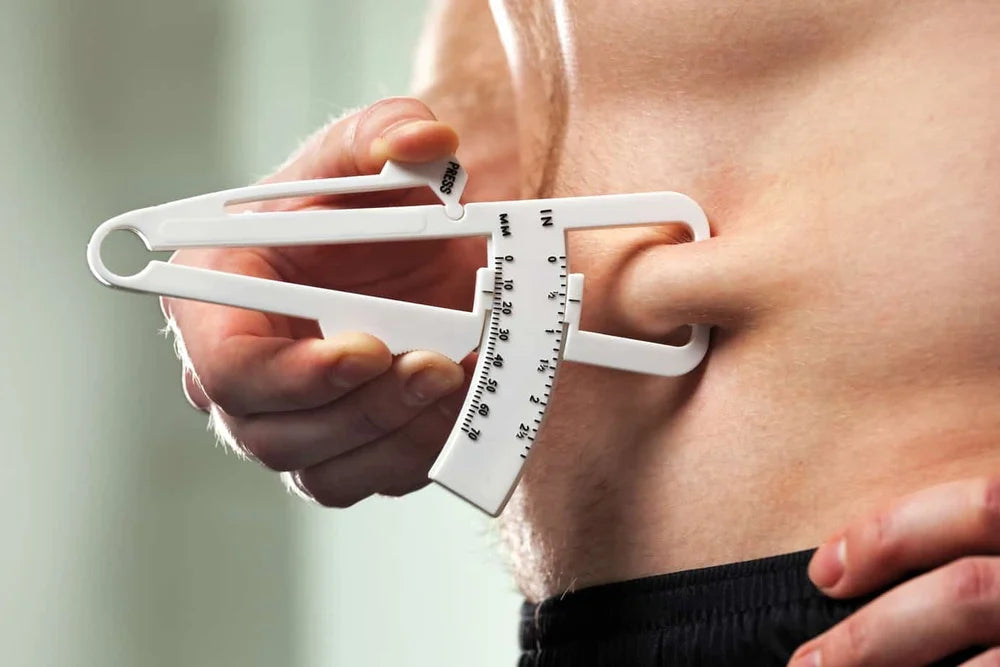
Skin Calipers
The skinfold test, also known as the pinch test, is an anthropometric method for measuring body fat. This technique involves pinching the subcutaneous fat layer with fingers and measuring its thickness using a caliper. Skin calipers are easily portable, and the measurement process is simple and inexpensive. However, this method estimates total Percent Body Fat (PBF) based solely on subcutaneous fat.
While a significant portion of body fat is subcutaneous, this measurement may not be accurate for individuals with varying fat distributions. Additionally, the method becomes challenging if the subcutaneous fat layer thickness exceeds 5 cm. The reproducibility of the results can also vary significantly depending on the measurer's skill.

Hydrostatic Weighing
Hydrostatic weighing, or underwater weighing, calculates total body fat based on body density. This method utilizes Archimedes' principle, which states that when an object is submerged in water, the difference between its mass in air and its mass in water equals the object's volume.
Hydrostatic weighing is considered the gold standard for body composition measurement. It is one of the few body composition technologies that have been directly compared to cadaver analysis, ensuring high accuracy.
Body Density = Mass in Air / (Mass in Air – Mass in Water)
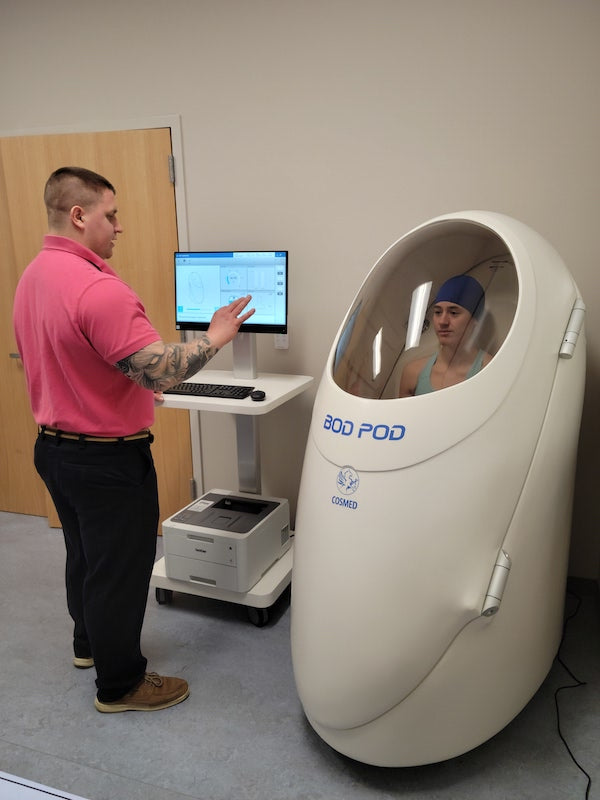
Air Displacement Plethysmography
Air displacement plethysmography measures body volume by assessing the volume of air displaced in a chamber, based on changes in pressure. This method calculates body density and subsequently determines Percent Body Fat (PBF) and the fat-free ratio.
The measurement process is relatively quick, typically taking 3-5 minutes. Unlike underwater weighing, this method allows the examinee to breathe normally in the chamber. Known as a gold standard for body composition analysis, air displacement plethysmography provides accurate measurements similar to underwater weighing by utilizing volume calculations.
Density = Mass / Volume
Percent Body Fat = (495 / Density) – 450
Fat-free Ratio = 100 – PBF%
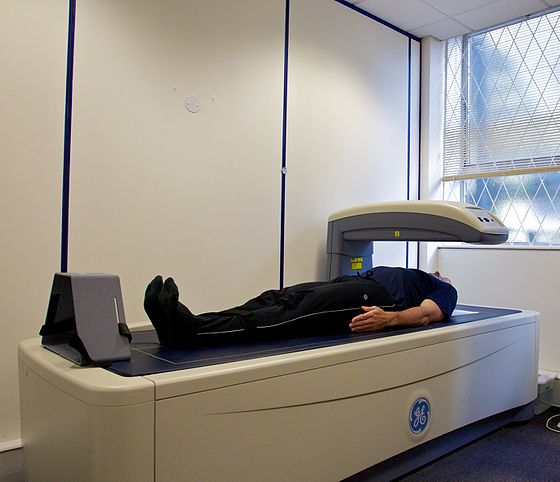
Dual Energy X-Ray Absorptiometry (DEXA)
DEXA is an advanced imaging method that measures Bone Mineral Content (BMC), lean mass, and fat mass by analyzing the reduction of X-ray intensity using two different X-ray beams. The process takes about 5 to 30 minutes while the patient lies down.
DEXA is highly accurate and can measure bone density, body fat, and muscle mass in different body parts. It has evolved from a two-compartment to a three-compartment model, differentiating between lean and fat tissue.
Appointments for a DEXA scan typically need to be made at hospitals or clinics with the necessary equipment, as not all facilities have DEXA devices.
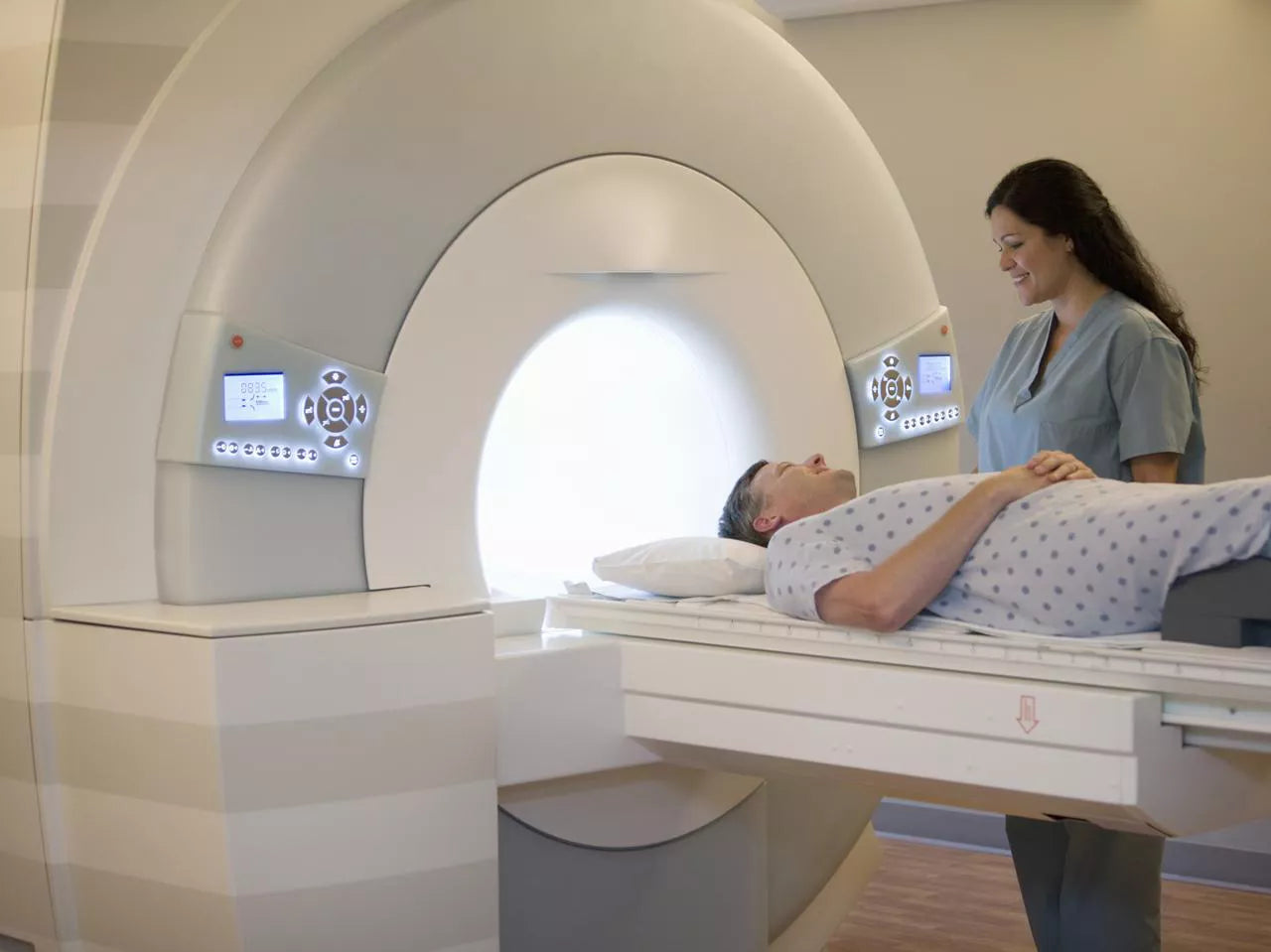
MRI (Magnetic Resonance Imaging)
MRI is an imaging technique that maps body water through segmental scans to predict whole-body values. It is considered the most accurate tool for in vivo body composition quantification, ideal for measuring skeletal muscle mass and adipose tissue, including visceral and subcutaneous fat.
MRIs use a high-strength magnet, so all metal objects must be removed. Individuals with metallic implants, surgical clips, pacemakers, or similar devices should avoid MRI scans. However, MRI is a safer option for many, such as the elderly and children, as it involves no ionizing radiation.
A whole-body MRI scan takes about 25-30 minutes, with an additional 3 hours needed for computer software analysis.

Bioelectric Impedance Analysis (BIA)
Bioelectric Impedance Analysis (BIA) measures body composition by assessing impedance using alternating electrical currents to determine body water volume. This non-invasive method involves placing electrodes on the feet, hands, or both. A low-level electrical current is passed through the body, with the flow affected by the amount of water present.
BIA devices measure how the electrical signal is impeded by different tissues—muscle has high conductivity, while fat slows the signal. By determining the resistance to the current flow, BIA provides estimates of body water, from which body fat is calculated using specific equations.



